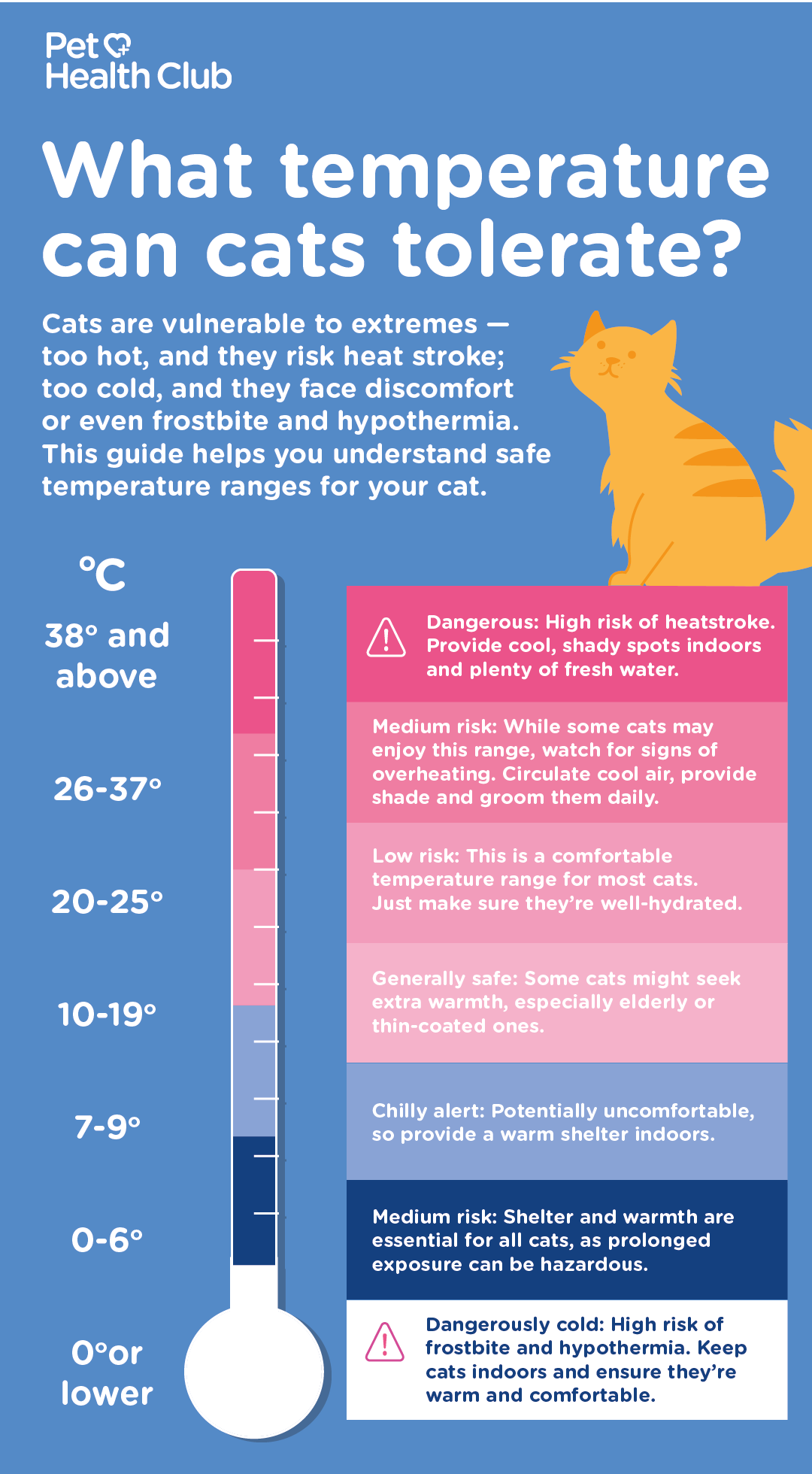Do cats get cold?
During the winter months, you might wonder do cats get cold. The short answer is yes. However, their tolerance to cold can vary.
Understanding and responding to your cat's needs for warmth is not just about comfort; it's important for their overall wellbeing. In this article, we’ll look at how to keep your cat comfortable, no matter how low the temperature drops outside.
Understanding a cat's body temperature
Cats have a higher body temperature than ours. Typically, it ranges between 38°C and 39°C. This higher body temperature is one of the many things that makes cats unique and helps them keep warm even when the temperature drops.
Signs your cat might be feeling cold
Shivering
If you see your cat shivering, it's a straightforward indication they’re feeling cold. Cats shiver for the same reason we do – to generate body heat when their surroundings are too cold for comfort. However, a cat shivering could also indicate anxiety, fear or excitement.
Seeking warmth
Cats like to be warm. That’s why they can often be found in sun puddles. But they may be feeling the cold if you find them curled up in clothes, next to a radiator or near the airing cupboard.
Curled-up posture
Cats are known for their love of curling up into cosy little balls, but this isn't just a cute pose. When cats curl up tightly, they’re trying to conserve body heat. This posture minimises the body's surface exposure to the cold, helping them retain heat.
Less active
If your usually playful cat is less active, preferring to stay in their warm spots rather than engage in usual activities, it could be a response to the cold. When cats are cold, they might prefer to huddle up in a warm place rather than move around too much.
What temperature can cats tolerate?

Read more: What colours can cats see?
Factors affecting a cat's sensitivity to cold
Several factors can influence how sensitive your cat is to colder temperatures. Understanding these can help you provide the best care for your cat during the colder months.
Age
Age significantly affects how well a cat can handle the cold. Kittens, with their still-developing bodies, and senior cats, who may have health issues, often struggle to regulate their body temperature. This means they can get cold more easily and might need extra warmth and care. Maintaining a warm and cosy environment is particularly important for these age groups.
Health
The overall health of your cat is another factor. Cats with certain health issues, like thyroid problems, can struggle more in the cold. These health conditions can affect their metabolism and their ability to stay warm. If your cat has any chronic health issues, it's a good idea to talk to your vet about how to keep them comfortable when it's cold outside.
Breed
Your cat's breed can also influence how sensitive they are to cold. Cats with short or no fur, such as Sphynx cats, are more susceptible to the cold because they lack the natural fur coat that provides insulation. On the other hand, breeds with thick, long fur, like the Norwegian Forest Cat, are better equipped to handle lower temperatures. However, even these cats can get cold if the temperature drops too much.
Read more: How to keep outdoor cats safe
Keeping your cat warm
Whether your cat spends most of their time indoors or ventures outside, you can help them keep warm in several ways.
Indoors
It’s important to create a warm and comfortable environment for indoor cats. You can do this by providing them with warm, cosy beds or blankets in their favourite spots. Since cats seek the warmest place in the house, it is important to ensure that these areas are away from drafts and cold floors. A warm igloo-style bed can be an ideal winter retreat for cats, as they love to snuggle in small, enclosed spaces.
Outdoor
If you have an outdoor cat or are caring for feral cats, providing them with an insulated shelter can make a big difference. These shelters should be waterproof and positioned to shield them from the wind. The entrance should be big enough for a cat to get in and out, and the inside can be lined with straw for added insulation. This helps outdoor cats find a safe spot to escape the cold weather.
Clothing
While some cats don't mind wearing sweaters, others may not tolerate them well. Observing your cat's behaviour and comfort level with clothing is important. For cats that tolerate clothing, ensure that sweaters or coats fit properly and don't restrict their movement or ability to use the litter box.
When to worry about your cat in the cold
While it's important to keep your cat warm and comfortable during cold weather, knowing what temperature poses a risk to their health is equally crucial. Prolonged exposure to cold temperatures can lead to hypothermia, where the body temperature drops dangerously low. This is a medical emergency and requires immediate attention.
Hypothermia in cats can occur when they are exposed to cold temperatures for an extended period, especially if wet or in windy conditions. It's more common in kittens, senior cats, and cats with health issues, but it can affect any cat if the conditions are severe enough.
Signs of hypothermia in cats
Several signs may indicate your cat’s suffering from hypothermia or other cold-related health issues. These include:
- Lethargy
- Unresponsiveness
- Very cold ears or paws
- Shivering
- Difficulty breathing
If you observe any of these signs, try to warm them gently. Wrap them in warm (not hot) blankets and provide a quiet resting place. However, avoid using direct heat sources like hot water bottles or heating pads, as these can cause burns or overheat your cat. When you’ve done this, call your vet.

Read more: What to do if your cat gets stung by a bee or wasp
Tips for monitoring and maintaining your cat's warmth
Keeping your cat warm and comfortable during the colder months is crucial for their well-being. Here are some practical tips to help you monitor and maintain your cat's warmth.
Regularly check your cat's ears and paws
These parts of a cat's body can give you a good indication of their overall temperature. Gently feel your cat's ears and paws. They should be warm, not cold. It might indicate your cat is not warm enough if they feel unusually cold. This is especially important for outdoor cats, as their extremities are more exposed to the cold.
Adjust your home heating
Maintaining a consistent, comfortable temperature in your home can go a long way in keeping your cat warm. This doesn't mean overheating your house but rather avoiding cold drafts and sudden drops in temperature. This is particularly important for kittens, senior cats, and cats with health issues.
Provide warm and cosy sleeping areas
Ensure your cat has access to warm, comfortable places to sleep. This could be a cat bed with extra blankets, a cushioned window seat where they can enjoy the sunlight, or even a cosy spot near a radiator. Cats love to find warm, enclosed spaces, so consider providing an igloo-style bed or a cat cave.
Consider a heated cat bed
A heated cat bed can be a great option for extra chilly days or if your cat is particularly sensitive to the cold. These beds provide gentle warmth and are designed to be safe for cats. Just make sure to follow all safety instructions and monitor its use.
Keep your cat active
Encouraging play and activity can help them stay warm by naturally increasing their body temperature. This is especially helpful for indoor cats. Regular play sessions with toys, interactive games, or even a cat tree to climb can keep them active and warm.
Be mindful of outdoor access
If your cat goes outdoors, be extra cautious during the winter months. Limit their time outside during extremely cold weather and always ensure they have a way to get back inside whenever they need to.
It's important to remember that each cat is unique. What works for one might not necessarily be right for another. Age, health, and breed significantly affect how your cat experiences and handles the cold. Therefore, while the tips provided here are a good starting point, they might need to be adjusted to suit your cat's needs.
What if your cat still seems cold?
When in doubt, the best action is to consult your vet. They can offer tailored advice and help you understand your cat's needs, ensuring you provide the best care possible.
Finally, take a proactive approach to keeping your cat comfortable and healthy during the colder months. Regular checks, creating a warm living space, and being attentive to your cat's behaviour are all part of this. By doing so, you'll not only help your cat through the winter months but also strengthen the bond you share with your cat. Stay warm and stay safe.
Need more advice?
If you’re concerned about your pet in any way during the cold weather, speak to your local vet or vet nurse.
Find your nearest vet using our find a vet page, or speak to one of our vets online using our video vets service.


